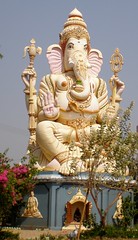 |
| The view from one of Noonmark's false summits |
I thought of false summits while leading a yoga class through a series of forward bends. We were working on moving to the edge of the stretch, lengthening our spines when we inhaled, releasing further forward with our exhales. The edge is uncomfortable and, like a false summit, makes you think you've gone as far as you can. Unless you give yourself time and muster up the fortitude to continue on, you'll never know what the view looks like from the top.
For the false summits of our forward bends, we can thank musculotendinous sensory receptors called Golgi tendon organs (GTOs). Through their reflexive actions, the GTOs help to regulate muscle stiffness. Low-force, long-duration static stretching, felt in the hamstrings during Paschimottanasana, brings on a temporary increase in tension as the muscles lengthen, the first "edge" we discover. Don't give up there because, after seven to 10 seconds of holding and breathing, your GTOs activate and the muscle tension temporarily releases. Another exhale and you'll find yourself deeper into the bend.
The muscle quickly reestablishes its stretch threshold and a new edge is reached. You may work through a few before you reach your true edge, provided you can stay patient, focused and breathing smoothly throughout the process. After practicing consistently for a period of weeks or months, the muscles will lengthen more or less permanently, so you'll be able to go further forward before reaching the first edge. As a result, the true summit of your yoga pose keeps getting further away.
The true summits of the Adirondack mountains keep getting further away, too. The Adirondack mountains are still growing, at a rate of about one millimeter per year. Some days, when it seems like we've been walking forever, I'm sure the mountain has gone through a recent growth spurt. Climbing these mountains requires patience, focus and lots of breath.















